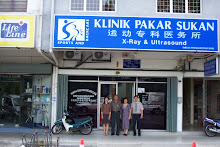Calf strain in golf
Calf strain or cramp which affects the muscles of the lower leg when playing golf is common. Many golfers have muscle tear confused with cramp. The two muscles (gastrocnemius and soleous) at the back of lower leg is call calf.
The typical leg muscle cramp is the sudden, tight and intense pain caused by a muscle locked in spasm. Whereas the muscles tear have similar symptoms except the pain last longer and more severe. You may hear a pop sound or feel a snap sensation. There is difficulty put weight on the affected leg and walking. One or two days later the calf muscles became swelling with or without bruises. The calf may also feel weak and stiff.
Muscle tear pain range in intensity from a discomfort in minor partial tear to agonizing pain in total tear. A muscle tear may feel hard to the touch and tight. A tear usually last a few days to weeks. Muscle tear generally have no serious long-term consequences.
Risk factors of calf muscle tear:
- Inadequate stretching muscles.
- Muscle fatigue.
- Very tight muscles.
- Golfing in hot environment.
- Poor fitness.
- Low carbohydrate levels.
- Overexertion or overuse.
Those golfers who are predisposed to muscle tear are related to extreme hot day, people over age 65, overweight or overexert during exercise. Muscle tear are more common among golfers who walk and play golf more than three times per week.
Calf muscle tear are graded according to their severity, with grade 1 being the least severe.
Grade 1
• Stretching with some microscopic tear of muscle fibers.
• Recovery takes up to 2-3 weeks.
• Partial tearing of muscle fibers.
• Recovery can take up to six weeks.
Grade 3
• Complete tearing (rupture) of muscle fibers.
• Complete recovery can take more than 3 months.
Self-treatment:
- Stop your golf.
- Elevation.
- Compression using elastic compression bandage.
- Gently stretch the painful muscle.
- Apply cold spray or ice pack to sore muscles.
- Reduce lower leg activities temporarily.
- See your doctor for pain relieve or anti-inflammatory medication.
Prevention:
- Improved overall fitness.
- Stretch the tight or stiff leg muscle that prone to tear daily.
- Stretch before and after golf.
- Warm up before golf and cool down after golf.
- Drink water before, during and after golf on regular intervals.
- Strengthen your calf muscles so they can absorb the energy of sudden physical stress.
- Know when your body has had enough. Fatigue puts you at risk for a strain.
Another injury with similar symptoms is a tear of the Achilles' tendon. That's a much more serious injury, and you'll need to see a doctor to differentiate between Achilles tendon tear and calf muscle tear.




Oustanding advice. Have had two strains in 3 yrs and every it takes 4-6 weeks to recover. I felt I was in outstanding condition, but probably need to be a little more diligent about stretching before/after play.
ReplyDeleteCompression with special calf support braces after injury makes a big difference in relieving pain and providing support to the leg.